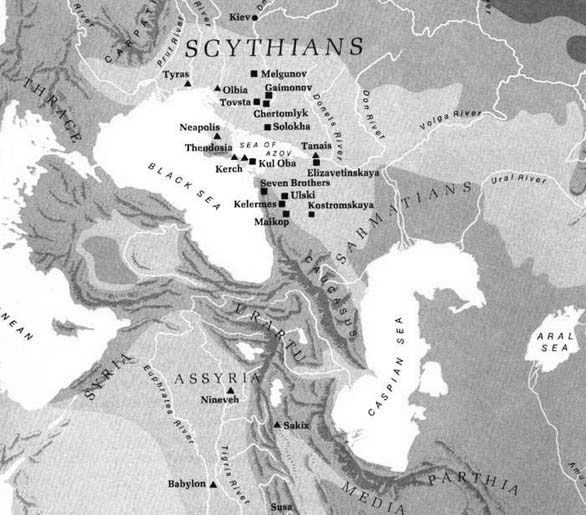8. Such is the account which the Scythians give of themselves, and of the country which lies above them. The Greeks who dwell about the Pontus tell a different story. According to Hercules, when he was carrying off the cows of Geryon, arrived in the region which is now inhabited by the Scyths, but which was then a desert. Geryon lived outside the Pontus, in an island called by the Greeks Erytheia, near Gades, which is beyond the Pillars of Hercules upon the Ocean.. . .From Scythes, the son of Hercules, were descended the after kings of Scythia; and from the circumstance of the goblet which hung from the belt, the Scythians to this day wear goblets at their girdles. This was the only thing which the mother of Scythes did for him. Such is the tale told by the Greeks who dwell around the Pontus.
SNIP
59. Thus abundantly are the Scythians provided with the most important necessaries. Their manners and customs come now to be described. They worship only the following gods, namely, Vesta, whom they reverence beyond all the rest, Jupiter, and Tellus, whom they consider to be the wife of Jupiter; and after these Apollo, Celestial Venus, Hercules, and Mars.
The Khazars and the Scythians [Other interesting stuff on this link--Fedora]

2. The legend, as told by Herodotus, have it that all "Scythians" were direct descendants of Hercules who had three sons from a mythical beast whose lower part was snakelike, and whose upper part was one of a hermaphrodite. Of this, let's call it 'marriage', the Hermaphrodite bore three sons: Agatirz, Gelon and Skit. (Readers will probably be aware that Hercules himself has nothing to do with the so-called Greek mythology and the Greek pantheon simply because he was a Thracian God much, much more ancient than the whole gang at Olympus Mountain.) 3. The Hercules' first son, called by Herodotus "Aga-tirz", was called by the people that descended from him "KOZAR". The Greek word "Agatirz" means "Goat-hunter" and is again a direct translation of the ethnonym "KOZAR" (goat-keeper or goat-hunter). Later, in the middle ages, in parallel with the changes in the Greek language, the pronunciation of the name of these peoples also changed and become "akatziri", "agatziri" or "agaziri". Something similar happened to the native, proto-Slav, name and it changed from "KOZAR" to "KOZAK" ("cossack"). (In antiquity, as partly in present days, they lived in the Carpathian Mountains, just to the north of the Lower Danube.) 4. In the 6th century AD, the Anonymous Chronograph of Ravenna, in its brief description of the KHAZARS, as one of the major peoples inhabiting Skitia (Scythia), specifies that, in the ancient times, they were called "akatzirs":Map showing the lands populated by the Scythians - they almost completely correspond with the state of the Khazars. From the The Scythians web site.
SNIP
THE RUSSIAN/SCYTHIAN/GREEK CONNECTION [BTW lots of nice maps on this link--Fedora]
Interestingly, we must go to Russia to begin the story of where the Celts came from. There is in Russia today, just east of the Ural Mountains on the Tobol River a town and an Oblast (Russian for province) known as Kurgan. The town and the term is Russian for tumulus, the distinctive mound-grave of the nomadic culture to whom the name Kurgan was given. The Kurgans were a pre-Celtic peoples from whom the Celts evolved. . .The people who moved in the Black Sea area when the early Kurgans moved on, where Cimmerians. They may have been a later generation of Kurgans moving west from the Russian Steppe as were those who displaced them, the Scythians. The Scythians were an outgrowth of the Kurgans. The Scythians pushed the Cimmerians in two directions, into Europe where they became known as the Cimbri, and into Asia Minor and Assyria. . .The Scythians were either a pre-Celtic peoples or a people who greatly influenced the Celts. Though the Scythians were in the Black Sea area and made raids into central Europe, Asia Minor and into southern central Asia, their original homeland was a band of land from the Dnieper River where it enters the Black Sea north to the headwaters of the Danube in central Europe, east to most of what was the southern Soviet Union and arcing north to Siberia. Their eastern boundary appeared to be the Yenesei River that feeds into Lake Baikal. The Greeks named their king after a son of Hercules, Scythes.
The Indo-Scythians (Sakas) were various Central Asian peoples who migrated into Bactria, Sogdiana, Hazara-Kashmir and finally into Arachosia and then India beginning in the middle of the 2nd century BC. Controversies abound.
SNIP
Spalahores with Spalagadames (circa 75 - 65 BC). . .Reverse: Hercules seated left. Kharosthi legend.